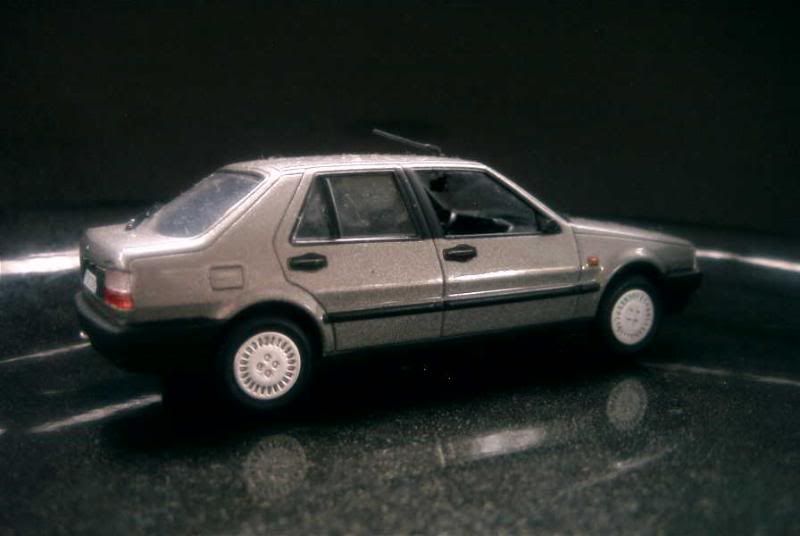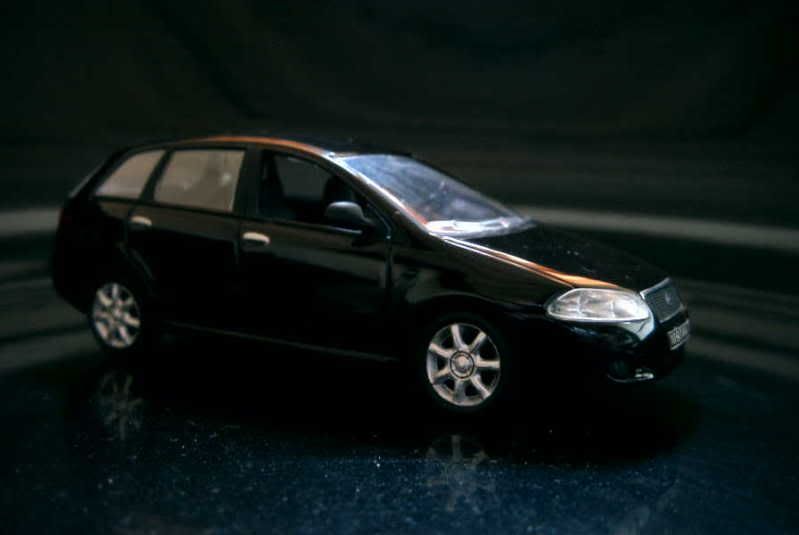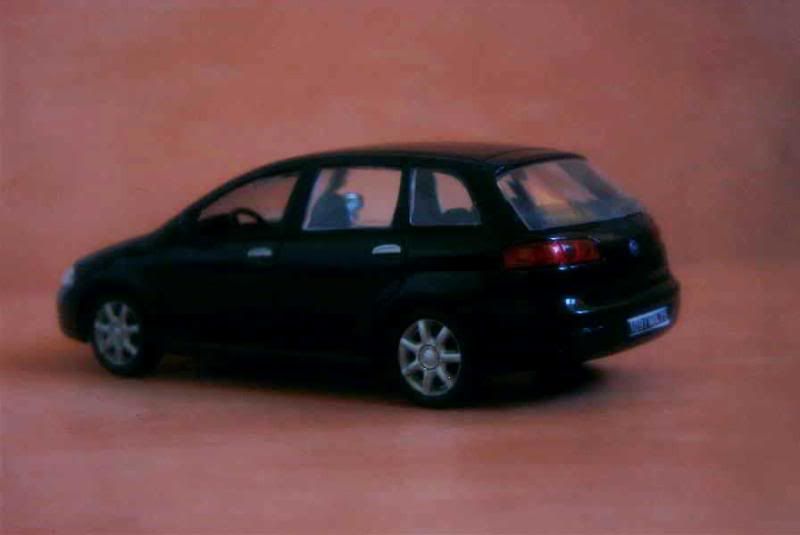A little history
You can’t help it: in the mind of most people, Fiat is exclusively constructing popular cars. Though the main Italian automobile company also built luxury cars both before World War Two (we have already seen the 2800, for example) and, to some extent, after (my favourite would be the coupe version of the 130, but there was also the Dino and the 8V), this is cars as the Topolino, 500, 600, 850, 127, 128 or Punto that most people remember. As a matter of fact, during the difficult Seventies, Fiat preferred concentrating on its lower range, preparing the modern Ritmo, than finding a successor to its larger saloons, the 132 and 130. Despite having been introduced in 1972, the 132 was nothing more than updated in 1981, becoming the Argenta. Finally, a brand-new car topped Fiat’s range in 1985: the Croma.
Actually, the Fiat Croma wasn’t exactly new when launched. Since the previous year, Lancia was proposing the Thema as a replacement for its Gamma, and gave its chassis, suspension and central structure to the Croma. Though the Pininfarina-styled Thema was offered as either a strict saloon or an estate, the more plebeian Croma was exclusively built as a practical 5-door liftback penned by Giorgetto Giugiaro. Some engines were also shared by both cars. Two years later, Alfa Romeo launched its elegant 164, also based on the Croma/Thema platform, but enjoying a totally different body. This cooperation didn’t stop at the Italian borders, as a fourth derivative was introduced as the Saab 9000, a Croma slightly adapted by Giugiaro for the Swedish company.
Designed as a family car, the front-wheel-drive Croma relied on plain 1.6- and 2.0-litre gasoline fours, along with a 2.5-litre diesel, that could be turbocharged or not. Those who wanted more performances could also find the car of their dreams among the Croma’s range, as a 16-valve injected 2.0-litre engine was also listed, as well as a turbocharged version rated at 150 hp.
After a 1991 facelift, the Croma was produced until 1996. Despite being successful both within Italy and, to some extent, without it, Fiat’s largest car left without a successor. Finally, the manufacturer was conforming to its image by sacrificing its upper range and concentrating on more saleable popular cars.
Croma could have been a forgotten nameplate today if, by 2005, it didn’t make a surprising comeback. Fiat re-entered the large family car market with a new Croma, available only as an estate but often classified as an MPV in order to avoid any comparison with its competitors’ saloons, better established in this segment. Fiat’s short-lived partnership with General Motors brought it to base its Nuova Croma on a platform already used by the Opel Vectra and – a case of history repeating itself – the Saab 9-3. Interestingly, this also linked the new car from Fiat, the paragon of cheap transportation, to the BLS, the smaller model proposed by… Cadillac! Today, the Croma still pursues its career – a rather discreet one.
About the models
Model: Fiat Croma
Year: c.1985
Maker: Norev
Scale: 1/43
Distributed by: Hachette as no.14 of its Fiat Story press series
Acquired: new with neither box nor stand (probably a production overrun or quality control reject), in January 2007, in Hong Kong, S.A.R.
Though quality is unremarkable, this is nonetheless an accurate model of the Croma. My rating is 12/20.


Model: Fiat (Nuova) Croma
Year: c.2005
Maker: Norev
Scale: 1/43
Distributed by: Hachette as no.25 of its Fiat Story press series
Acquired: new with neither box nor stand (probably a production overrun or quality control reject), in February 2007, in Shenzhen, China.
The same remarks apply to this model, pulled out of the same Italian series. Same rating too: 12/20.



You can’t help it: in the mind of most people, Fiat is exclusively constructing popular cars. Though the main Italian automobile company also built luxury cars both before World War Two (we have already seen the 2800, for example) and, to some extent, after (my favourite would be the coupe version of the 130, but there was also the Dino and the 8V), this is cars as the Topolino, 500, 600, 850, 127, 128 or Punto that most people remember. As a matter of fact, during the difficult Seventies, Fiat preferred concentrating on its lower range, preparing the modern Ritmo, than finding a successor to its larger saloons, the 132 and 130. Despite having been introduced in 1972, the 132 was nothing more than updated in 1981, becoming the Argenta. Finally, a brand-new car topped Fiat’s range in 1985: the Croma.
Actually, the Fiat Croma wasn’t exactly new when launched. Since the previous year, Lancia was proposing the Thema as a replacement for its Gamma, and gave its chassis, suspension and central structure to the Croma. Though the Pininfarina-styled Thema was offered as either a strict saloon or an estate, the more plebeian Croma was exclusively built as a practical 5-door liftback penned by Giorgetto Giugiaro. Some engines were also shared by both cars. Two years later, Alfa Romeo launched its elegant 164, also based on the Croma/Thema platform, but enjoying a totally different body. This cooperation didn’t stop at the Italian borders, as a fourth derivative was introduced as the Saab 9000, a Croma slightly adapted by Giugiaro for the Swedish company.
Designed as a family car, the front-wheel-drive Croma relied on plain 1.6- and 2.0-litre gasoline fours, along with a 2.5-litre diesel, that could be turbocharged or not. Those who wanted more performances could also find the car of their dreams among the Croma’s range, as a 16-valve injected 2.0-litre engine was also listed, as well as a turbocharged version rated at 150 hp.
After a 1991 facelift, the Croma was produced until 1996. Despite being successful both within Italy and, to some extent, without it, Fiat’s largest car left without a successor. Finally, the manufacturer was conforming to its image by sacrificing its upper range and concentrating on more saleable popular cars.
Croma could have been a forgotten nameplate today if, by 2005, it didn’t make a surprising comeback. Fiat re-entered the large family car market with a new Croma, available only as an estate but often classified as an MPV in order to avoid any comparison with its competitors’ saloons, better established in this segment. Fiat’s short-lived partnership with General Motors brought it to base its Nuova Croma on a platform already used by the Opel Vectra and – a case of history repeating itself – the Saab 9-3. Interestingly, this also linked the new car from Fiat, the paragon of cheap transportation, to the BLS, the smaller model proposed by… Cadillac! Today, the Croma still pursues its career – a rather discreet one.
About the models
Model: Fiat Croma
Year: c.1985
Maker: Norev
Scale: 1/43
Distributed by: Hachette as no.14 of its Fiat Story press series
Acquired: new with neither box nor stand (probably a production overrun or quality control reject), in January 2007, in Hong Kong, S.A.R.
Though quality is unremarkable, this is nonetheless an accurate model of the Croma. My rating is 12/20.


Model: Fiat (Nuova) Croma
Year: c.2005
Maker: Norev
Scale: 1/43
Distributed by: Hachette as no.25 of its Fiat Story press series
Acquired: new with neither box nor stand (probably a production overrun or quality control reject), in February 2007, in Shenzhen, China.
The same remarks apply to this model, pulled out of the same Italian series. Same rating too: 12/20.






No comments:
Post a Comment